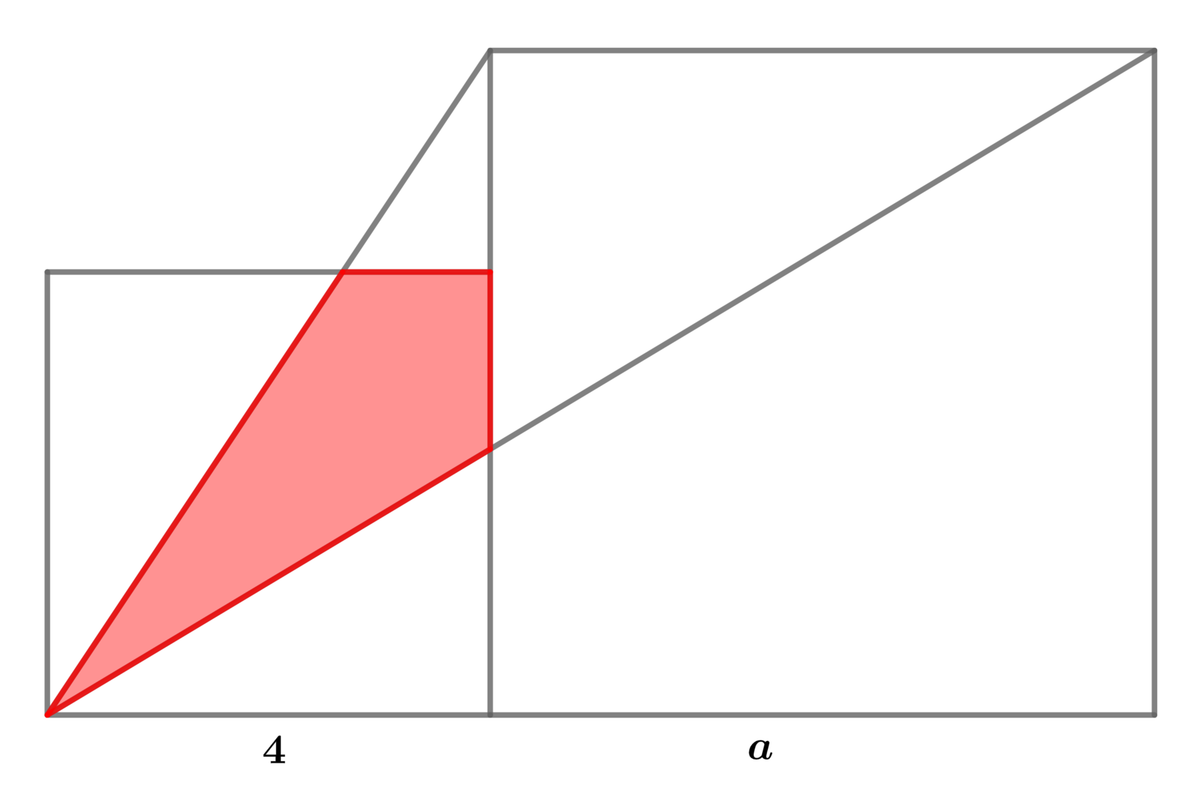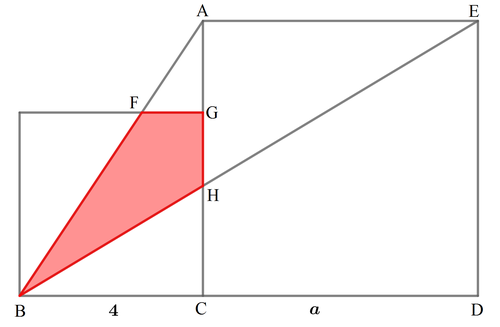An Area Problem

In the diagram above, the smaller and the larger squares have side lengths 4 and a respectively.
Find the value of a for which the area of the red region is 1 5 8 8 .
The answer is 6.
This section requires Javascript.
You are seeing this because something didn't load right. We suggest you, (a) try
refreshing the page, (b) enabling javascript if it is disabled on your browser and,
finally, (c)
loading the
non-javascript version of this page
. We're sorry about the hassle.
3 solutions

Label the figure as shown. Then we note that the area of the red region is given by
[ A B C ] − [ A F G ] − [ B C H ] = 1 5 8 8
[ A B C ] = 2 4 a = 2 a . Since △ A F G and △ A B C are similar, we have [ A F G ] = A C 2 A G 2 × [ A B C ] = a 2 ( a − 4 ) 2 × 2 a = a 2 ( a − 4 ) 2 . Again △ B C H and △ B D E are similar, [ B C H ] = B D 2 B C 2 × [ B D E ] = ( a + 4 ) 2 4 2 × 2 a ( a + 4 ) = a + 4 8 a . Then we have:
2 a − a 2 ( a − 4 ) 2 − a + 4 8 a 2 a − 2 a + 1 6 − a 3 2 − a + 4 8 a 2 − a 4 − a + 4 a a 2 + 4 a 4 a + 1 6 + a 2 1 + a 2 + 4 a 1 6 a 2 + 4 a 1 6 a 2 + 4 a 4 a 2 + 4 a − 6 0 ( a − 6 ) ( a + 1 0 ) ⟹ a = 1 5 8 8 = 1 5 8 8 = 1 5 1 1 = 2 − 1 5 1 1 = 2 − 1 5 1 1 = 1 5 4 = 1 5 1 = 0 = 0 = 6 Since a > 0

With the labelling shown on the figure, we have
△ A B I ∼ △ A E F ⇒ F E I B = A E A B ⇒ a x = 4 + a 4 ⇒ x = 4 + a 4 a
△ G H C ∼ △ G A B ⇒ A B H C = G B G C ⇒ 4 y = a a − 4 ⇒ y = a 4 ( a − 4 )
[ A H C I ] = [ A H C ] + [ A C I ] = 2 1 H C ⋅ A D + 2 1 C I ⋅ A B = 2 1 [ 4 y + 4 ( 4 − x ) ] = 2 y − 2 x + 8
Combining we get
2 a 4 ( a − 4 ) − 2 4 + a 4 a + 8 = 1 5 8 8 ⇔ … ⇔ a 2 + 4 a − 6 0 = 0 ⇔ a > 0 a = 6 .
m A C = 4 a ⟹ y = 4 a x and B D is y = 4 ⟹ 4 a x = 4 ⟹ x = a 1 6 ⟹
P : ( a 1 6 , 4 )
m A E = 4 + a a ⟹ y = 4 + a a x and C F is x = 4 ⟹ y = 4 + a 4 a ⟹
Q : ( 4 , 4 + a 4 a )
A △ A B P = 2 1 ( A B ) ( B P ) = 2 B P = 2 ( a 1 6 ) = a 3 2
A △ A Q F = 2 1 ( A F ) ( Q F ) = 2 Q F = 2 ( 4 + a 4 a ) = 4 + a 8 a
A A B D F = 1 6
⟹ The total area A T = 1 5 8 8 = 1 6 − ( a 3 2 + 4 + a 8 a ) = 8 ( a ( a + 4 ) a 2 + 4 a − 1 6 ) ⟹
a ( a + 4 ) a 2 + 4 a − 1 6 = 1 5 1 1 ⟹ 1 5 a 2 + 6 0 a − 2 4 0 = 4 4 a + 1 1 a 2 ⟹
4 a 2 + 1 6 a − 2 4 0 = 0 ⟹ a 2 + 4 a − 6 0 = 0 ⟹ ( a − 6 ) ( a + 1 0 ) = 0
and a = − 1 0 ⟹ a = 6